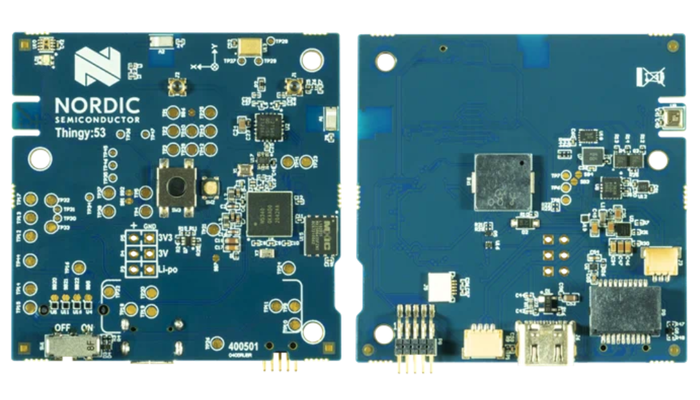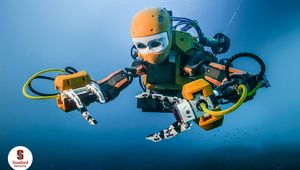Nordic Semiconductor Thingy:53
A rapid prototyping platform based on nRF5340 SoC, with integrated sensors for developing new prototypes and building proofs-of-concept swiftly.
Technical Specifications
| System On Chip (SoC) | nRF5340 SoC |
| Application Core | 128 MHz Arm Cortex-M33, 1 MB Flash + 512 KB RAM |
| Network Core | 64 MHz Arm Cortex-M33, 256 KB Flash + 64 KB RAM |
| Wireless Protocol Support | Bluetooth LE/Bluetooth mesh/NFC/ Thread/Zigbee/2.4 GHz proprietary |
| Battery | 1350 mAh Li-Po, USB-C rechargeable |
| Environmental Sensors | Temperature, Humidity, Air Quality, Air Pressure |
Overview
Nordic Semiconductor Thingy:53 is a multi-sensor, multi-protocol wireless prototyping platform built around nRF5340 SoC. It has built-in motion, light, sound, temperature, humidity, and pressure sensors. This makes it possible to create prototypes and build proofs-of-concept in less time without the need to build custom hardware. Thingy:53 supports Bluetooth mesh, Bluetooth LE, Zigbee, Thread, Matter, proprietary 2.4 GHz, and NFC. The memory size and processing power of its dual Arm Cortex-M33 processors allow it to run embedded machine learning (ML) models directly on the device.
Designed for Rapid Prototyping
Nordic Semiconductor Thingy:53 is pre-installed with firmware to work with the nRF Edge Impulse mobile app. This paves the way to create and run embedded machine learning applications directly on the Thingy:53 with Edge Impulse Studio. This helps transfer sensor data wirelessly over Bluetooth LE to the mobile device and upload it to the cloud. Trained ML models to Thingy:53 can be downloaded for inferencing and deployment. The application also acts as the GUI for viewing inferencing results from a running ML model.
Thingy:53's sensors can be used for applications like movement pattern detection or voice recognition. The PDM microphone and low-power accelerometer can also wake SoC from sleep on sound or motion events. This is useful for creating low-power embedded machine learning applications, which help the device save power and remain asleep when it is idle and has nothing to react to.
Thingy:53 Products and Features
At the core of the Thingy:53, there is a dual-core SoC to date, nRF5340. The processing power and memory size of nRF5340 SoC inside the device allow it to run ML models smoothly. With nRF21540 RF FEM adding range extension features and nPM1100 PMIC handling charging of the internal battery, Thingy:53 features three different types of ICs from Nordic Semiconductor all at once. There is a separate core for wireless connectivity in addition to 1 MB of flash storage and 512 kB of RAM on the main application core. Both cores are Arm Cortex-M33, running at up to 128 and 64 MHz, respectively.
Thingy:53 features a variety of different sensors. An environmental sensor measures the temperature, humidity, gas, and pressure around it. There is a magnetometer, color, and light sensor in the casing. The 6-axis inertial measurement unit can be used as a gyroscope and accelerometer to give an app awareness of the Thingy`s orientation. These sensors collect data and run embedded ML models directly on the device.
Thingy:53 is powered by a 1350 mAh rechargeable Li-Po battery that can be charged using USB-C. There is a microphone with the capabilities of PDM and wake-on-sound. The MEMS microphone has the ability to wake the nRF5340 from sleep on input detection. The device also includes a buzzer, an NFC antenna, two buttons, and one RGB LED that simplifies input and output.
A handy little flap on the bottom of the casing allows direct access to Thingy's power switch and all external connections. A 4-pin JST connector is compatible with standards like Qwiic, Groove, and Stemma, allowing easy integration with external accessories. There is a slot for debug- and current measurement board with every Thingy:53. This is used for measuring power consumption and debugging the application code.
Using Nordic Semiconductor Thingy:53
Follow these eight steps to try out an ML model:
Power on Thingy:53, download the nRF Edge Impulse app from Apple App Store or Google Store.
Log into your Edge Impulse app account or create the new one from the app.
Connect to your new Thingy:53 by selecting the device named Edgeimpulse in the app.
Go to the Inferencing tab and press start.
Take Thingy:53 in your hand and make the wave motion.
Do the up-down motion.
Do the snake motion.
Notice the inference results in the app.
You can use nRF Connect SDK to develop applications containing compatible libraries and samples. The Nordic Semiconductor Thingy:53 can be used for machine learning, smart home sensing, fast prototyping, and proof-of-concept development applications.
Where to find it

Mouser Electronics
Mouser Electronics is a worldwide leading authorized distributor of semiconductors and electronic components.












